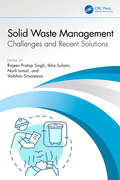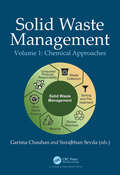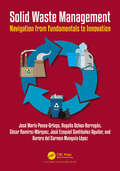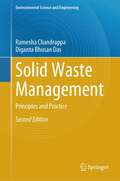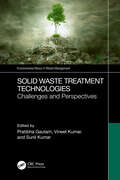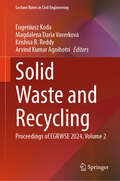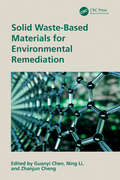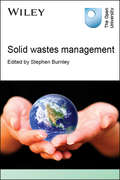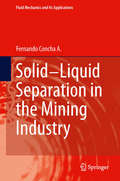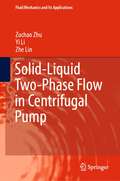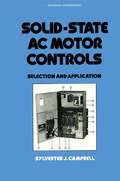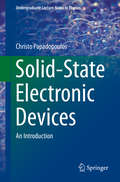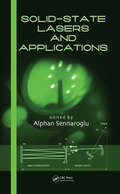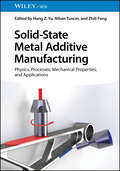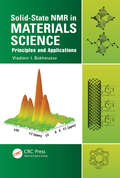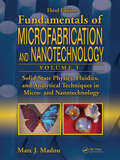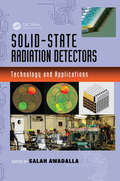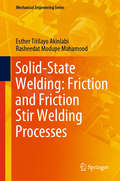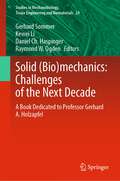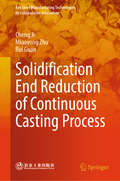- Table View
- List View
Solid Waste Management: Challenges and Recent Solutions
by Rajeev Pratap Singh Vaibhav Srivastava Norli Ismail Ibha SuhaniThis book provides a holistic picture of waste and its management techniques, with all the recent advancements and necessary projections for the future, which aim to maximize the value-added products for environmental sustainability on a cost-effective basis. It emphasizes the practices, problems, and management of a broad variety of industrial solid waste and facilitates a major understanding of the utilization of sustainable tools to combat all types of problems.The book: Provides a holistic approach toward the topic to channelize waste management globally. Discusses waste minimization and regulation in conjunction with other integrated solutions and equipment. Reviews updated information and data for use to modify the system for advanced waste management. Explores innovative methods for defining, sorting, and treating solid waste. Includes case studies in each chapter for analyzing the concepts explored in the real world. This book is aimed at graduate students and researchers in civil and environmental engineering, and waste management.
Solid Waste Management: Chemical Approaches, Volume 1
by Surajbhan Sevda Garima Chauhan‘Waste’ is generally identified as goods or material that are perceived to be mostly valueless. However, objects that are perceived to be waste based on consumers’ object valuation can be redefined to create value. This requires a multitude of efforts using different strategies in waste prevention and management. This book is an edited collection of various chemical approaches used for valorization of solid wastes, particularly, waste electrical and electronic equipment, plastic waste, and agro-residue waste, that provide research insights into the concept "waste-to-energy". Covering a variety of interdisciplinary topics on waste treatment and resource recovery makes the book one for all that serves as an excellent reading material for engineers, science scholars, entrepreneurs, and organizations who are working in the field of waste management.
Solid Waste Management: Navigating from Fundamentals to Innovation
by José María Ponce-Ortega César Ramírez-Márquez Rogelio Ochoa-Barragan Jose Ezequiel Santibanez-Aguilar Aurora del Carmen Munguia-LopezSolid Waste Management: Navigation from Fundamentals to Innovation is a compendium that unravels the complexities of waste management. It traverses the historical backdrop of waste management practices and ushers in a realm where sustainability and cutting-edge technologies converge to tackle the escalating challenges of waste disposal and treatment. This book serves a diverse readership, i.e. students, researchers, educators, and practitioners. It has an interdisciplinary approach and provides a holistic view of the field, blending theory with actionable strategies, and infusing the narrative with innovative solutions.With a focus on sustainability, it underscores the integration of emerging technologies, such as AI and IoT, in optimizing waste management systems. It equips readers with the knowledge to navigate the intricacies of the industry and fosters the adoption of efficient, sustainable waste practices. As we stand on the brink of environmental exigencies, this book calls for action in a more responsible and forward-thinking manner to managing the byproducts of our civilization.
Solid Waste Management: Principles and Practice (Environmental Science and Engineering)
by Ramesha Chandrappa Diganta Bhusan DasThis book discusses solid waste management issues from global to local level. It offers an overview of the methods and paradigms of this burgeoning field, ranging from generation, characteristics, quantity, and practical challenges. The book discusses the major issues with respect to environmental health and economy, which are related to solid waste management. Furthermore, it contains updated information on topics such as toxicology, climate change, population pressure, urbanization, energy production, building and community design, and disaster preparedness in the context of solid waste management.
Solid Waste Management: Volume 2: Biological/Biochemical Approaches
by Surajbhan Sevda Garima ChauhanWaste materials in the solid form tend to be bulky and difficult to handle and transport. Its management could happen through physical, thermal, chemical or biological processing stages, with the exact sequence of and their operational optima being decided by the waste composition. In recent years, energy crisis and increased waste production have been undoubtedly major issues of concern. As we mentioned in the previous volume of this book, defining waste is crucial in terms of identifying the most adequate approach to recycle or recover resources from the waste. Various chemical, biochemical, and biological approaches are being investigated widely by researchers for waste valorization. Volume 2 of this book brings together the leading researchers working on solid waste management using biological and biochemical approaches.
Solid Waste Treatment Technologies: Challenges and Perspectives (Environmental Nexus in Waste Management)
by Sunil Kumar Vineet Kumar Pratibha GautamSustainable waste management is a major step towards the attainment of Sustainable Development Goals. This book covers all technical, managerial, and legislative aspects of waste management at a global scale, providing a detailed description about different types of wastes, their characteristics, legal perspectives, and sustainable practices for their management. It explains developments in waste treatment technologies (classified based on waste type) and understanding the fundamentals of circular economy in waste management, supported by various case studies.Features: Discusses fundamentals of solid waste management for sustainable waste management practices Describes technological aspects of waste management covering various physicochemical, biochemical, and thermochemical processes Summarizes regulatory framework for waste management at the global level Highlights the scope for circular economy in managing solid wastes Includes dedicated chapters on case studies imperative for capacity building in waste management This book is aimed at researchers, graduate students, and professionals in environmental engineering, and waste management.
Solid Waste and Recycling: Proceedings of EGRWSE 2024, Volume 2 (Lecture Notes in Civil Engineering #579)
by Krishna R. Reddy Arvind Kumar Agnihotri Eugeniusz Koda Magdalena Daria VaverkováThis volume contains peer-reviewed and selected papers presented during the International Conference on Environmental Geotechnology, Recycled Waste Materials, and Sustainable Engineering 2024, held in Warsaw, Poland. It covers the recent innovations, trends, concerns, practical challenges encountered, and the solutions adopted in waste management and engineering, geotechnical and geoenvironmental engineering, infrastructure engineering, and sustainable engineering. This book will be useful for academics, educators, policymakers, and professionals working in the field of civil engineering, chemical engineering, environmental sciences, and public policy.
Solid Waste-Based Materials for Environmental Remediation
by Guanyi ChenThis book provides a multifaceted examination of solid waste management methods, the preparation, properties, and application of solid waste materials in the remediation of various environmental media, as well as the combination of solid waste materials and artificial intelligence.Based on the latest research results and cutting-edge technologies from around the world, the contributors combine the design principles of solid waste materials with application examples, including a complete system, clear routes, and illustrations. They integrate the idea of ecological civilization, the concept of sustainable development, and engineering innovation thinking, providing a reliable reference for resource recycling and contributing to global low-carbon emission.The book is suitable for teachers and students, as well as researchers, industrial technicians, and managers involved in solid waste resources and environmental remediation.
Solid Wastes Management
by Stephen BurnleySolid Wastes Management begins with a focus on processing municipal and similar commercial, as well as industrial wastes; assessing and minimising the environmental impacts of processing and disposal. The second section reviews the treatment technologies available (physical, biological and thermal), their advantages, disadvantages and environmental performance. The third section considers the environmental and health impacts of the technologies and reviews the use of models to predict landfill leachate, gas formation and pollution dispersion. The fourth section is on the human health impact of waste management and draws on the previous sections, bringing in pollutants such as bioaerosols and ultra-fine particulate material. In the fifth and sixth sections, the importance of adopting an integrated approach to waste management is demonstrated through consideration of life cycle assessment and its use to determine optimum waste management solutions.
Solid, Liquid, Gassy! (Fairy Science)
by Ashley SpiresFairy scientist Esther is experimenting with the water cycle in this enchanting STEM-and-magic-filled follow-up to Fairy Science, a picture book from the award-winning author-illustrator of The Most Magnificent Thing!When a pond dries up, fairy scientist Esther doesn't freeze under the pressure. She and her friends go full steam ahead for to make a scientific discovery! Bestselling author Ashley Spires (The Most Magnificent Thing) creates a charming primer to the water cycle. Includes an at-home water experiment for the budding scientist in your house!
Solid-Liquid Separation in the Mining Industry
by Fernando Concha A.This book covers virtually all of the engineering science and technological aspects of separating water from particulate solids in the mining industry. It starts with an introduction to the field of mineral processing and the importance of water in mineral concentrators. The consumption of water in the various stages of concentration is discussed, as is the necessity of recovering the majority of that water for recycling. The book presents the fundamentals under which processes of solid-liquid separation are studied, approaching mixtures of discrete finely divided solid particles in water as a basis for dealing with sedimentation in particulate systems. Suspensions, treated as continuous media, provide the basis of sedimentation, flows through porous media and filtration. The book also considers particle aggregations, and thickening is analyzed in depth. Lastly, two chapters cover the fundamentals and application of rheology and the transport of suspensions. This work is suitable for researchers and professionals in laboratories and plants, and can also serve as additional reading for graduate courses on solid liquid separation as well as for advanced undergraduate and graduate level students for courses of fluid mechanics, solid-liquid separation, thickening, filtration and transport of suspensions in tubes and channels.
Solid-Liquid Thermal Energy Storage: Modeling and Applications
by Moghtada MobediSolid–Liquid Thermal Energy Storage: Modeling and Applications provides a comprehensive overview of solid–liquid phase change thermal storage. Chapters are written by specialists from both academia and industry. Using recent studies on the improvement, modeling, and new applications of these systems, the book discusses innovative solutions for any potential drawbacks. This book: Discusses experimental studies in the field of solid–liquid phase change thermal storage Reviews recent research on phase change materials Covers various innovative applications of phase change materials (PCM) on the use of sustainable and renewable energy sources Presents recent developments on the theoretical modeling of these systems Explains advanced methods for enhancement of heat transfer in PCM This book is a reference for engineers and industry professionals involved in the use of renewable energy systems, energy storage, heating systems for buildings, sustainability design, etc. It can also benefit graduate students taking courses in heat transfer, energy engineering, advanced materials, and heating systems.
Solid-Liquid Two-Phase Flow in Centrifugal Pump (Fluid Mechanics and Its Applications #136)
by Yi Li Zuchao Zhu Zhe LinThis book conducts a systematic study on internal flow characteristics and performance of centrifugal pump for solid–liquid mixed transportation. First, the applicability of the computational model for two-phase flow is analyzed. Then the relationship between the two-phase flow characteristics and wall wear in the pipeline is revealed. And the flow characteristics in centrifugal pumps are analyzed in relation to conveying performance and wall wear. Finally, the engineering application calculation of the mixed transportation pump with different impeller structures is carried out. The target audience of this book is researchers who perform calculations and engineering applications of solid–liquid two-phase pumps.This book considers the influence of the particle size on the force magnitude of the particles and analyzes the applicability of different solid–liquid two-phase calculation models. Considering the different motion trajectories of particles colliding with dry wall, wet wall, stationary wall, and moving wall, visual experiments are used to study the collision rebound model of different walls. The collision rebound model is applied to the numerical simulation of solid–liquid mixed transport.
Solid-State AC Motor Controls: Selection and Application
by Sylveste CampbellThis book discusses the current status of the solid-state AC motor controls. It treats most technical phenomena in the empirical sense, with emphasis on input-output characteristics of solid-state controls, oriented at all times to their effect on the performance of the AC motor.
Solid-State Electronic Devices
by Christo PapadopoulosA modern and concise treatment of the solid state electronic devices that are fundamental to electronic systems and information technology is provided in this book. The main devices that comprise semiconductor integrated circuits are covered in a clear manner accessible to the wide range of scientific and engineering disciplines that are impacted by this technology. Catering to a wider audience is becoming increasingly important as the field of electronic materials and devices becomes more interdisciplinary, with applications in biology, chemistry and electro-mechanical devices (to name a few) becoming more prevalent. Updated and state-of-the-art advancements are included along with emerging trends in electronic devices and their applications. In addition, an appendix containing the relevant physical background will be included to assist readers from different disciplines and provide a review for those more familiar with the area. Readers of this book can expect to derive a solid foundation for understanding modern electronic devices and also be prepared for future developments and advancements in this far-reaching area of science and technology.
Solid-State Lasers and Applications (Optical Science and Engineering)
by Alphan SennarogluBecause of the favorable characteristics of solid-state lasers, they have become the preferred candidates for a wide range of applications in science and technology, including spectroscopy, atmospheric monitoring, micromachining, and precision metrology. Presenting the most recent developments in the field, Solid-State Lasers and Applications focuses on the design and applications of solid-state laser systems.With contributions from leading international experts, the book explores the latest research results and applications of solid-state lasers as well as various laser systems. The beginning chapters discuss current developments and applications of new solid-state gain media in different wavelength regions, including cerium-doped lasers in the ultraviolet range, ytterbium lasers near 1µm, rare-earth ion-doped lasers in the eye-safe region, and tunable Cr2+:ZnSe lasers in the mid-infrared range. The remaining chapters study specific modes of operation of solid-state laser systems, such as pulsed microchip lasers, high-power neodymium lasers, ultrafast solid-state lasers, amplification of femtosecond pulses with optical parametric amplifiers, and noise characteristics of solid-state lasers. Solid-State Lasers and Applications covers the most important aspects of the field to provide current, comprehensive coverage of solid-state lasers.
Solid-State Metal Additive Manufacturing: Physics, Processes, Mechanical Properties, and Applications
by Zhili Feng Hang Z. Yu Nihan TuncerSolid-State Metal Additive Manufacturing Timely summary of state-of-the-art solid-state metal 3D printing technologies, focusing on fundamental processing science and industrial applications Solid-State Metal Additive Manufacturing: Physics, Processes, Mechanical Properties, and Applications provides detailed and in-depth discussion on different solid-state metal additive manufacturing processes and applications, presenting associated methods, mechanisms and models, and unique benefits, as well as a detailed comparison to traditional fusion-based metal additive manufacturing. The text begins with a high-level overview of solid-state metal additive manufacturing with an emphasis on its position within the metal additive manufacturing spectrum and its potential for meeting specific demands in the aerospace, automotive, and defense industries. Next, each of the four categories of solid-state additive technologies—cold spray additive manufacturing, additive friction stir deposition, ultrasonic additive manufacturing, and sintering-based processes—is discussed in depth, reviewing advances in processing science, metallurgical science, and innovative applications. Finally, the future directions of these solid-state processes, especially the material innovation and artificial intelligence aspects, are discussed. Sample topics covered in Solid-State Metal Additive Manufacturing include: Physical processes and bonding mechanisms in impact-induced bonding and microstructures and microstructural evolution in cold sprayed materialsProcess fundamentals, dynamic microstructure evolution, and potential industrial applications of additive friction stir depositionMicrostructural and mechanical characterization and industrial applications of ultrasonic additive manufacturingPrinciples of solid-state sintering, binder jetting-based metal printing, and sintering-based metal additive manufacturing methods for magnetic materialsCritical issues inherent to melting and solidification, such as porosity, high residual stress, cast microstructure, anisotropic mechanical properties, and hot cracking Solid-State Metal Additive Manufacturing is an essential reference on the subject for academic researchers in materials science, mechanical, and biomedicine, as well as professional engineers in various manufacturing industries, especially those involved in building new additive technologies.
Solid-State NMR in Materials Science: Principles and Applications
by Vladimir I. BakhmutovSolid-state NMR is a powerful physical method widely applied in modern fundamental and applied science, medicine, and industry. Its role is particularly valuable in materials chemistry due to the capability of solid-state NMR to rapidly solve tasks connected with structural descriptions of complex systems on macro and/or molecular levels, and the i
Solid-State NMR in Zeolite Catalysis (Lecture Notes in Chemistry #103)
by Jun Xu Qiang Wang Shenhui Li Feng DengSolid-State NMR Characterization of Heterogeneous Catalysts and Catalytic Reactions provides a comprehensive account of state-of-the-art solid-state NMR techniques and the application of these techniques in heterogeneous catalysts and related catalytic reactions. It includes an introduction to the basic theory of solid-state NMR and various frequently used techniques. Special emphasis is placed on characterizing the framework and pore structure, active site, guest-host interaction, and synthesis mechanisms of heterogeneous catalysts using multinuclear one- and two-dimensional solid-sate NMR spectroscopy. Additionally, various in-situ solid-state NMR techniques and their applications in investigation of the mechanism of industrially important catalytic reactions are also discussed. Both the fundamentals and the latest research results are covered, making the book suitable as a reference guide for both experienced researchers in and newcomers to this field.Feng Deng is a Professor at Wuhan Institute of Physics and Mathematics, Chinese Academy of Sciences.
Solid-State Physics, Fluidics, and Analytical Techniques in Micro- and Nanotechnology
by Marc J. MadouProviding a clear theoretical understanding of MEMS and NEMS, Solid-State Physics, Fluidics, and Analytical Techniques in Micro- and Nanotechnology focuses on nanotechnology and the science behind it, including solid-state physics. It provides a clear understanding of the electronic, mechanical, and optical properties of solids relied on in integra
Solid-State Radiation Detectors: Technology and Applications (Devices, Circuits, and Systems #41)
by SALAH AWADALLA AND KRZYSZTOF INIEWSKIIntegrating aspects of engineering, application physics, and medical science, Solid-State Radiation Detectors: Technology and Applications offers a comprehensive review of new and emerging solid-state materials-based technologies for radiation detection. Each chapter is structured to address the current advantages and challenges of each material and technology presented, as well as to discuss novel research and applications. Featuring contributions from leading experts in industry and academia, this authoritative text:Covers modern semiconductors used for radiation monitoringExamines CdZnTe and CdTe technology for imaging applications including three-dimensional capability detectorsHighlights interconnect technology for current pixel detectorsDescribes hybrid pixel detectors and their characterizationsTackles the integrated analog signal processing read-out front ends for particle detectorsConsiders new organic materials with direct bandgap for direct energy detectionSummarizes recent developments involving lanthanum halide and cerium bromide scintillatorsAnalyzes the potential of recent progress in the field of crystallogenesis, quantum dots, and photonics crystals toward a new concept of x- and gamma-ray detectors based on metamaterialsExplores position-sensitivity photomultipliers and silicon photomultipliers for scintillation crystalsSolid-State Radiation Detectors: Technology and Applications provides a valuable reference for engineers and scientists looking to enhance the performance of radiation detector technology for medical imaging and other applications.
Solid-State Sensors (IEEE Press Series on Sensors)
by Ravinder Dahiya Ambarish Paul Mitradip BhattacharjeeSolid-State Sensors A thorough and up-to-date introduction to solid-state sensors, materials, fabrication processes, and applications Solid-State Sensors provides a comprehensive introduction to the field, covering fundamental principles, underlying theories, sensor materials, fabrication technologies, current and possible future applications, and more. Presented in a clear and accessible format, this reader-friendly textbook describes the fundamentals and classification of all major types of solid-state sensors, including piezoresistive, capacitive, thermometric, optical bio-chemical, magnetic, and acoustic-based sensors. Throughout the text, the authors offer insight into how different solid-state methods complement each other as well as their respective advantages and disadvantages in relation to specific devices and a variety of state-of-the-art applications. Detailed yet concise chapters include numerous visual illustrations and comparative tables of different subtypes of sensors for a given application. With in-depth discussion of recent developments, current research, and key challenges in the field of solid-state sensors, this volume: Describes solid-state sensing parameters and their importance in sensor characterization Explores possible future applications and breakthroughs in associated fields of research Covers the fundamental principles and relevant equations of sensing phenomena Discusses promising smart materials that have the potential for sensing applications Includes an overview of the history, classification, and terminology of sensors With well-balanced coverage of the fundamentals of sensor design, current and emerging applications, and the most recent research developments in the field, Solid-State Sensors is an excellent textbook for advanced students and professionals in disciplines such as Electrical and Electronics Engineering, Physics, Chemistry, and Biomedical Engineering.
Solid-State Welding: Friction and Friction Stir Welding Processes (Mechanical Engineering Series)
by Rasheedat Modupe Mahamood Esther Titilayo AkinlabiThis book presents critical information on the principles and operation of friction welding, friction stir welding, and friction stir processing enhanced with many robust illustrations. It explains the application of these technologies and the current research efforts in the field. The authors explain in detail the advantages offered by these welding processes, in particular their ability to join dissimilar materials not possible to weld in the past. Written for graduate students, researchers, and industrial professionals, the book reinforces concepts presented with case studies on the experimental analysis of welding the dissimilar materials of copper and aluminum, and on friction stir processing.
Solid: A Book Dedicated to Professor Gerhard A. Holzapfel (Studies in Mechanobiology, Tissue Engineering and Biomaterials #24)
by Raymond W. Ogden Gerhard Sommer Kewei Li Daniel Ch. HaspingerThis book offers a comprehensive and timely overview of the latest developments in the field of biomechanics and extensive knowledge of tissue structure, function, and modeling. Gathering chapters written by authoritative scientists, it reports on a range of continuum and computational models of solids, and related experimental works, for biomechanical applications. It discusses cutting-edge advances such as constitutive modeling and computational simulation of biological tissues and organs under physiological and pathological conditions, and their mechanical characterization. It covers innovative studies on arteries, heart, valvular tissue, and thrombus, brain tumor, muscle, liver, kidney, and stomach, among others. Written in honor of Professor Gerhard A. Holzapfel, the book provides specialized readers with a thorough and timely overview of different types of modeling in biomechanics, and current knowledge about biological structures and function.
Solidification End Reduction of Continuous Casting Process (Key Steel Manufacturing Technologies by Collaborative Innovation)
by Miaoyong Zhu Cheng Ji Rui GuanThis book summarizes the formation of solidification defects in continuous casting strand and the process mechanism of improving central segregation, porosity and shrinkage under solidification end reduction. The behavior rules of shell deformation, crack initiation and propagation, solute transport, shrinkage cavity closure, microstructure refinement and evolution during solidification end reduction process were systematically expounded. It introduces how to realize the accurate, efficient and stable implementation of the solidification end reduction in the production process, and the design and development of key equipment. Finally, taking the specific production lines of Baosteel and Panzhihua Iron and Steel Co., Ltd. as examples, the industrial application and effect of solidification end reduction technology are listed.
